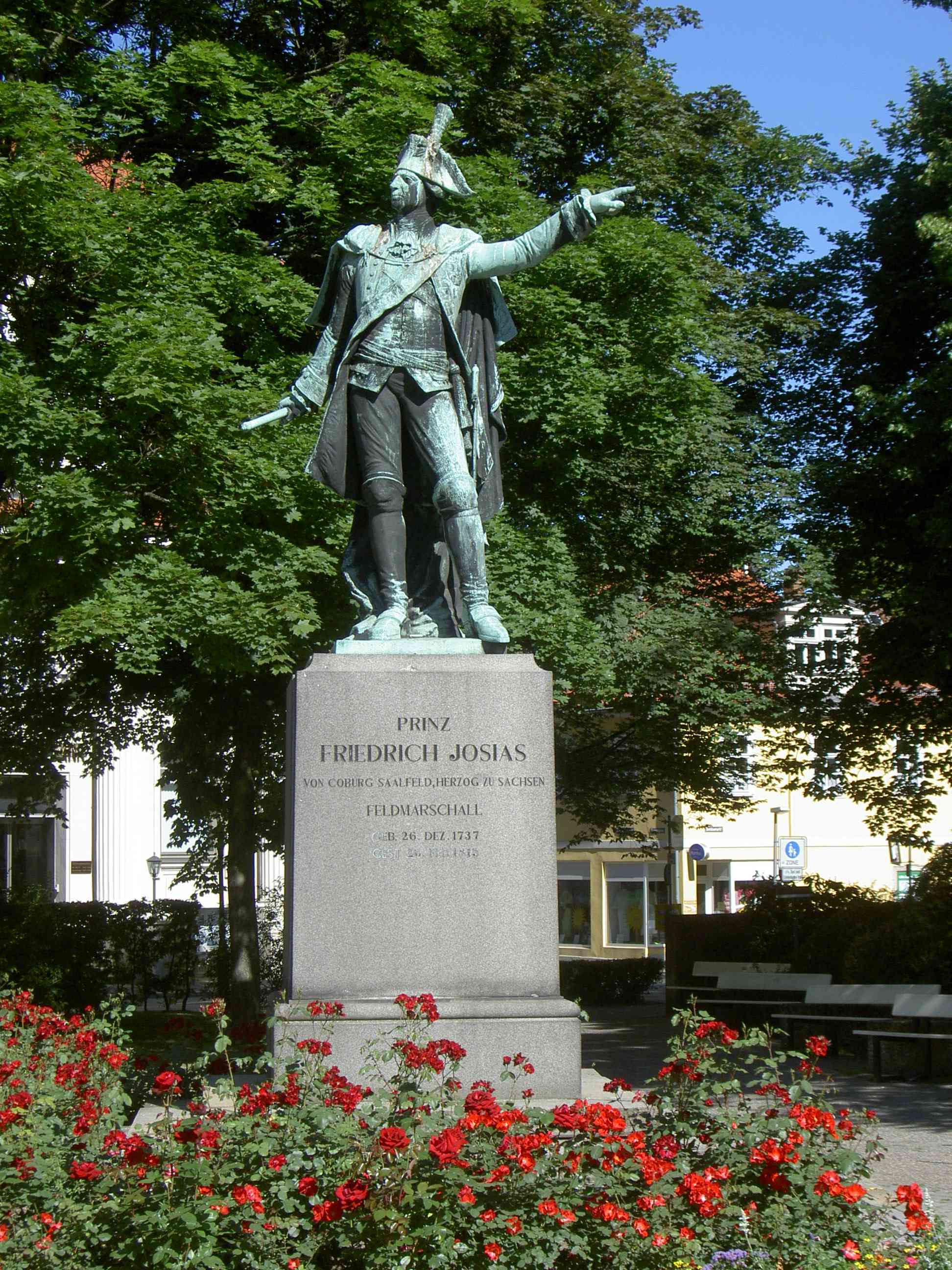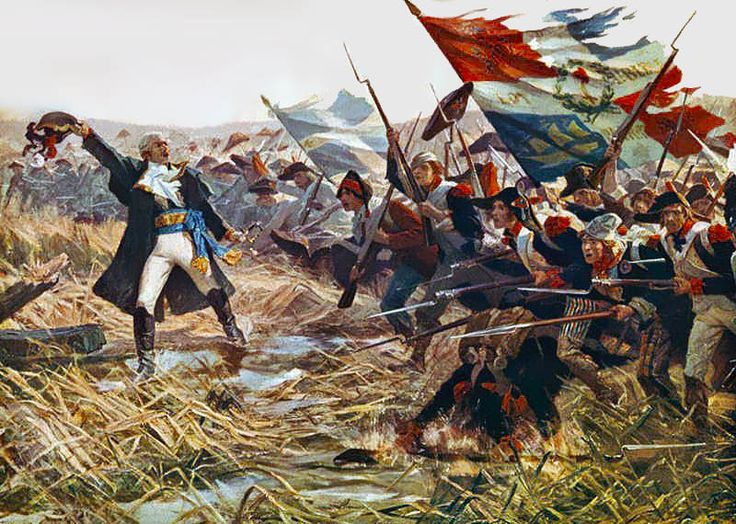|
Prince Josias Of Coburg
Prince Frederick Josias of Saxe-Coburg-Saalfeld (; 26 December 1737 – 26 February 1815) was a military commander in the army of the Holy Roman Empire. He began his career at the age of 18 in a cavalry regiment with which he took part in the Seven Years' War. Coburg's bravery allowed him to quickly rise through the ranks. Promoted to colonel in 1759, he became a general officer in the following years and, in this capacity, took command of an army corps during the Austro-Turkish War. Coburg campaigned successfully in Moldavia where he won the battles of Focşani, Rymnik and Martinestje against the Ottomans, which earned him the rank of field marshal in 1789. Thanks to his extensive experience, Coburg was appointed supreme commander of the Imperial Army in the Austrian Netherlands at the beginning of the French Revolutionary Wars. He triumphed at the Battle of Aldenhoven, then at the Battle of Neerwinden in March 1793, but these victories were overshadowed some time later by ... [...More Info...] [...Related Items...] OR: [Wikipedia] [Google] [Baidu] |
Prince
A prince is a male ruler (ranked below a king, grand prince, and grand duke) or a male member of a monarch's or former monarch's family. ''Prince'' is also a title of nobility (often highest), often hereditary, in some European states. The female equivalent is a princess. The English word derives, via the French word ''prince'', from the Latin noun , from (first) and (head), meaning "the first, foremost, the chief, most distinguished, noble ruler, prince". In a related sense, now not commonly used, all more or less sovereign rulers over a state, including kings, were "princes" in the language of international politics. They normally had another title, for example king or duke. Many of these were Princes of the Holy Roman Empire. Historical background The Latin word (older Latin *prīsmo-kaps, ), became the usual title of the informal leader of the Roman senate some centuries before the transition to empire, the '' princeps senatus''. Emperor Augustus establishe ... [...More Info...] [...Related Items...] OR: [Wikipedia] [Google] [Baidu] |
Austro-Turkish War (1788–1791)
The Austro-Turkish War, also known as the Habsburg–Ottoman War, was fought from 1788 to 1791, between the Habsburg monarchy and the Ottoman Empire. During the conflict, Habsburg armies succeeded in taking Belgrade (1789) and liberating much of central Serbia, also capturing several forts in central Croatia and in the Pounje region of the Ottoman Bosnia. Much of those gains were lost in the later stages of the war, that ended by the Treaty of Sistova (1791), with minor territorial changes in favor of the Habsburg side. The war was fought concomitantly with the Russo-Turkish War (1787–1792). War aims The war began soon after the breakout of the Russian-Turkish conflict. The Russian Empire, headed by Catherine the Great, had been involved in previous wars of conquest against the Ottomans, and the two nations were openly hostile. In August 1787, after "numerous Russian provocations" according to Hochedlinger, the Ottoman Empire declared war on the Russians. The Austrian E ... [...More Info...] [...Related Items...] OR: [Wikipedia] [Google] [Baidu] |
Battle Of Wattignies
The Battle of Wattignies (15–16 October 1793) saw a French army commanded by Jean-Baptiste Jourdan attack a Coalition army directed by Prince Josias of Saxe-Coburg-Saalfeld. After two days of combat Jourdan's troops compelled the Habsburg covering force led by François Sébastien Charles Joseph de Croix, Count of Clerfayt to withdraw. The War of the First Coalition victory allowed the French to raise the siege of Maubeuge. At a time when failed generals were often executed or imprisoned, Jourdan had to endure interference from Lazare Carnot from the Committee of Public Safety. The village, renamed Wattignies-la-Victoire in honor of the important success, is located southeast of Maubeuge. Coburg's main army encircled 25,000 French soldiers in Maubeuge while about 22,000 Austrians under Clerfayt were formed in a semi-circle, covering the southern approaches to the fortress. On the first day, 45,000 French soldiers mounted a clumsy attack which was easily repulsed, except ... [...More Info...] [...Related Items...] OR: [Wikipedia] [Google] [Baidu] |
Battle Of Caesar's Camp
The Battle of Caesar's Camp (7–8 August 1793) saw the Coalition army led by Prince Josias of Saxe-Coburg-Saalfeld try to envelop a Republican French army under Charles Edward Jennings de Kilmaine. Numerically superior Habsburg Austrian, British and Hanoverian columns converged on the fortified French camp, but Kilmaine wisely decided to slip away toward Arras. The War of the First Coalition skirmish was fought near Cambrai, France, and the village of Marquion located northwest of Cambrai. Adam Philippe, Comte de Custine, the previous commander of the Army of the North was ordered to Paris, where he was soon arrested and guillotined. Kilmaine was requested to lead the army until a permanent replacement arrived. Two Austrian columns set out to strike the French front while a British and Hanoverian column under Prince Frederick, Duke of York and Albany marched completely behind the French army. Though one representative on mission urged Kilmaine to attack, the general de ... [...More Info...] [...Related Items...] OR: [Wikipedia] [Google] [Baidu] |
Battle Of Famars
The Battle of Famars was fought on 23 May 1793 during the Flanders Campaign of the War of the First Coalition. An Allied Austrian, Hanoverian, and British army under Prince Josias of Saxe-Coburg-Saalfeld defeated the French Army of the North led by François Joseph Drouot de Lamarche. The battle occurred near the village of Famars in northern France, five km south of Valenciennes Valenciennes (, also , , ; ; or ; ) is a communes of France, commune in the Nord (French department), Nord Departments of France, department, Hauts-de-France, France. It lies on the Scheldt () river. Although the city and region experienced .... Background In May 1793, following a series of reverses the French Republican army in the Low Countries was in a desperate situation. Dispirited after the death of its former commander Augustin-Marie Picot de Dampierre, it was tired and disorganised. In addition it was further weakened by detachments taken from each battalion to serve in the war in ... [...More Info...] [...Related Items...] OR: [Wikipedia] [Google] [Baidu] |
Battle Of Raismes (1793)
A battle is an occurrence of combat in warfare between opposing military units of any number or size. A war usually consists of multiple battles. In general, a battle is a military engagement that is well defined in duration, area, and force commitment. An engagement with only limited commitment between the forces and without decisive results is sometimes called a skirmish. The word "battle" can also be used infrequently to refer to an entire operational campaign, although this usage greatly diverges from its conventional or customary meaning. Generally, the word "battle" is used for such campaigns if referring to a protracted combat encounter in which either one or both of the combatants had the same methods, resources, and strategic objectives throughout the encounter. Some prominent examples of this would be the Battle of the Atlantic, Battle of Britain, and the Battle of France, all in World War II. Wars and military campaigns are guided by military strategy, whereas ... [...More Info...] [...Related Items...] OR: [Wikipedia] [Google] [Baidu] |
Battle Of Neerwinden (1793)
The Battle of Neerwinden (18 March 1793) saw a First French Republic, Republican French army led by Charles François Dumouriez attack a Coalition army commanded by Prince Josias of Saxe-Coburg-Saalfeld. The Coalition army of the Habsburg monarchy together with a small contingent of allied Dutch Republic troops repulsed all French assaults after bitter fighting and Dumouriez conceded defeat, withdrawing from the field. The French position in the Austrian Netherlands swiftly collapsed, ending the threat to the Dutch Republic and allowing Austria to regain control of its lost province. The War of the First Coalition engagement was fought at Neerwinden, located east of Brussels in present-day Belgium. After Dumouriez's victory at Battle of Jemappes, Jemappes in November 1792, the French armies rapidly overran most of the Austrian Netherlands. Rather than driving the Austrians to the west bank of the Rhine River, Dumouriez and the French government became preoccupied with a war wi ... [...More Info...] [...Related Items...] OR: [Wikipedia] [Google] [Baidu] |
Battle Of Aldenhoven (1793)
The Battle of Aldenhoven (1 March 1793) saw the Habsburg Austrian army commanded by Prince Josias of Saxe-Coburg-Saalfeld attack a Republican French force under René Joseph de Lanoue. The Austrians successfully crossed the Roer River and engaged in a cavalry charge led by Archduke Charles, Duke of Teschen which routed the French and inflicted heavy losses. The War of the First Coalition battle occurred near Aldenhoven, a city in North Rhine-Westphalia, Germany located about west of Cologne. After a victory in the Battle of Jemappes on 6 November 1792, the French army of Charles Francois Dumouriez conquered most of the Austrian Netherlands. That winter, Dumouriez attempted to overrun the Dutch Republic while Francisco de Miranda besieged Maastricht, covered by Lanoue's troops along the Roer. Sent by the Austrian government to reconquer Belgium, Coburg's troops attacked early on the morning of 1 March and dispersed the French. The Battle of Neerwinden on 18 March would ... [...More Info...] [...Related Items...] OR: [Wikipedia] [Google] [Baidu] |
Low Countries Theatre Of The War Of The First Coalition
The Low Countries theatre of the War of the First Coalition, also known as the Flanders campaign, was a series of campaigns in the Low Countries conducted from 20 April 1792 to 7 June 1795 during the first years of the War of the First Coalition. As the French Revolution radicalised, the revolutionary National Convention and its predecessors broke the Catholic Church's power (1790), abolished the monarchy (1792) and even executed the deposed king Louis XVI of France (1793), vying to spread the Revolution beyond the new French Republic's borders, by violent means if necessary. The First Coalition, an alliance of reactionary states representing the Ancien Régime in Central and Western Europe – Habsburg Austria (including the Southern Netherlands), Prussia, Great Britain, the Dutch Republic (the Northern Netherlands), Hanover and Hesse-Kassel – mobilised military forces along all the French frontiers, threatening to invade Revolutionary France and violently restore the m ... [...More Info...] [...Related Items...] OR: [Wikipedia] [Google] [Baidu] |
French Revolutionary Wars
The French Revolutionary Wars () were a series of sweeping military conflicts resulting from the French Revolution that lasted from 1792 until 1802. They pitted French First Republic, France against Kingdom of Great Britain, Great Britain, Habsburg monarchy, Austria, Kingdom of Prussia, Prussia, Russian Empire, Russia, and several other countries. The wars are divided into two periods: the War of the First Coalition (1792–1797) and the War of the Second Coalition (1798–1802). Initially confined to Europe, the fighting gradually assumed a global dimension. After a decade of constant warfare and aggressive diplomacy, France had conquered territories in the Italian peninsula, the Low Countries, and the Rhineland with its very large and powerful military which had been totally mobilized for war against most of Europe with mass conscription of the vast French population. French success in these conflicts ensured military occupation and the spread of revolutionary principles over mu ... [...More Info...] [...Related Items...] OR: [Wikipedia] [Google] [Baidu] |
Battle Of Calafat
A battle is an occurrence of combat in warfare between opposing military units of any number or size. A war usually consists of multiple battles. In general, a battle is a military engagement that is well defined in duration, area, and force commitment. An engagement with only limited commitment between the forces and without decisive results is sometimes called a skirmish. The word "battle" can also be used infrequently to refer to an entire operational campaign, although this usage greatly diverges from its conventional or customary meaning. Generally, the word "battle" is used for such campaigns if referring to a protracted combat encounter in which either one or both of the combatants had the same methods, resources, and strategic objectives throughout the encounter. Some prominent examples of this would be the Battle of the Atlantic, Battle of Britain, and the Battle of France, all in World War II. Wars and military campaigns are guided by military strategy, whereas batt ... [...More Info...] [...Related Items...] OR: [Wikipedia] [Google] [Baidu] |
Siege Of Giurgiu (1790)
The siege of Giurgiu was launched by the Austrian army led by Prince Coburg, who besieged the Ottoman city of Giurgiu in 1790. The Siege ended in fiasco for the Austrians and was one of the last engagements in the Austro-Turkish War of 1788–1791. Background The ongoing war with the Ottomans took a toll on the Austrians; their emperor Joseph had died, and their country was on the verge of war with Prussia, who were allied with the Ottomans, which forced Austria to withdraw parts of their forces against Prussia. The Russian general, Alexander Suvorov, made plans with the Austrian general, Prince Coburg, to launch an offensive against the Ottomans. Their plan was to capture Orșova and Giurgiu and to cross the Danube River. However, the Russian prince, Grigory Potemkin, disapproved of this plan as he simply disliked Prince Coburg considering him incompetent and selfish. Coburg decided to take matters on his own without the help of Russia. The prince began the siege of Orșova. T ... [...More Info...] [...Related Items...] OR: [Wikipedia] [Google] [Baidu] |








